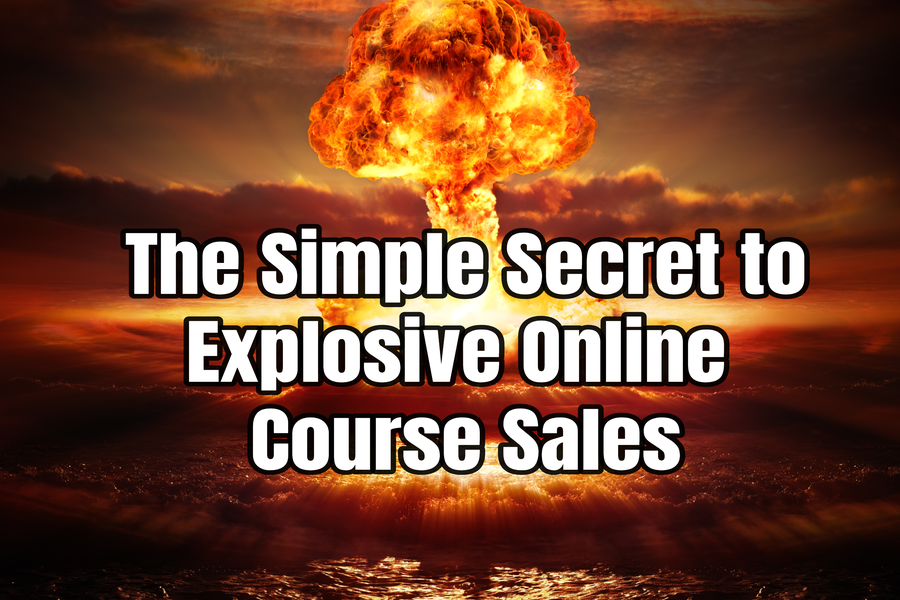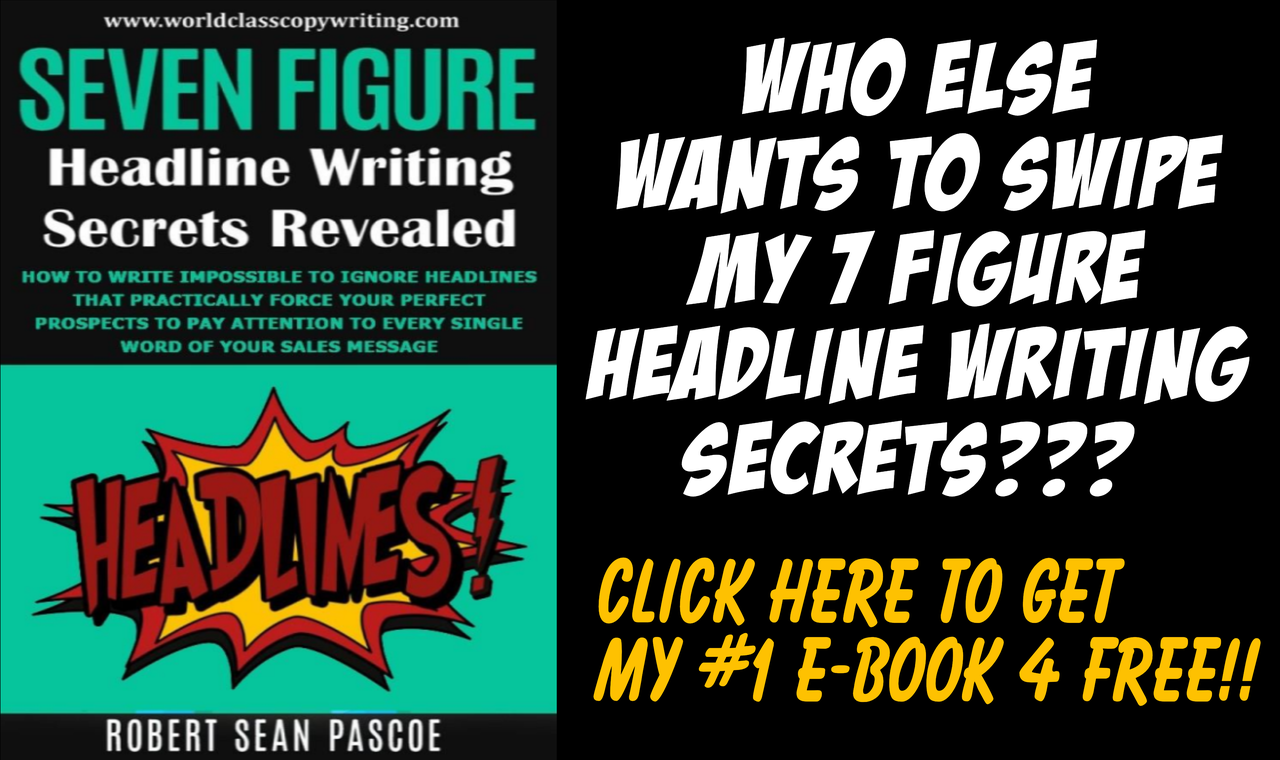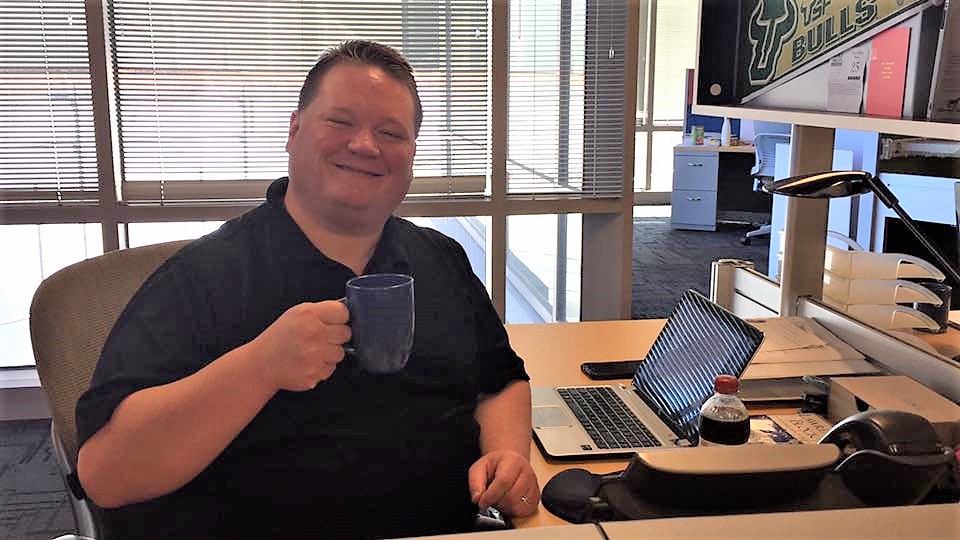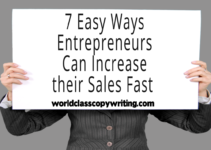If you’re an online course creator who wants to dramatically increase your SALES and PROFITS, then this article is going to show you exactly what the power of copywriting can do for your business.
My name is Robert, and I’m a freelance direct response copywriter how has extensive experience in writing powerful sales copy for online course creators in a wide variety of niches.
Markets as diverse as Christian Education to Knife Fighting Self Defense, and the one thing that has PROVEN to be the determining factor in their success, has been the quality of the sales copy promoting them.
You see, every day we’re inundated by a flurry of words. They flutter around in texts, social media updates, emails, and even those quick coffee chats with neighbors. Often, we don’t give them a second thought.
But here’s a little secret: when harnessed right, words have power—serious, game-changing power.
Especially in the realm of online sales.
So, why am I, your friendly neighborhood copywriter, going on about this? Because today, we’re embarking on a little journey—one that’ll spotlight the immense, often understated, power of words. By the time you reach the end of this post, you’ll see, in vivid technicolor, the tangible impact of effective copywriting on boosting those online course sales.
Ready to delve into the world where words don’t just speak, but sell? Let’s dive in.
The Connection Between Copywriting and Purchasing Decisions
Ever watched a heartwarming commercial and found yourself with misty eyes, even if it’s just about, say, a brand of tissue paper? Or perhaps you’ve read a product description that made you feel like you weren’t just buying a product, but embracing a new lifestyle or unlocking a part of yourself you didn’t know existed.
That’s the magic of words in action, and it’s no accident. It’s strategic copywriting.
Words: The Invisible Puppeteers of Emotion
At the core of every purchasing decision, there’s emotion. Whether it’s the comfort of knowing you’re making a wise investment, the thrill of treating yourself, or the hope of solving a pressing problem, emotions drive actions. And words? They’re the catalysts.
Copywriting—good copywriting, that is—taps into the human psyche. It understands the motivations, fears, and aspirations of its audience and speaks to them directly. It’s like having a heart-to-heart conversation, where one side voices concerns or desires, and the other offers reassurance, solutions, or visions of a better tomorrow.
Crafting Decisions with Words
Every word choice, sentence structure, and call to action is a nudge. A nudge toward viewing a product or service in a particular light.
For instance, consider the difference between:
#1. “Our course provides information on digital marketing.”
#2. “Unlock the secrets of digital marketing and propel your business to new heights!”
While both essentially convey the same core message, the second does so with panache. It promises transformation, not just information. It implies there’s a treasure trove of knowledge waiting to be discovered—a secret that can be the game-changer.
This choice of words doesn’t just provide information; it evokes emotion. Curiosity, excitement, ambition. And when emotions are stirred, decisions are influenced.
The Delicate Dance of Logic and Emotion
Now, it’s essential to clarify that influencing decisions isn’t about manipulation. Far from it. It’s about presenting information in a way that resonates, connects, and elucidates the value on offer. While emotions play a massive role, they’re often partnered with logic—the benefits, features, and tangible takeaways that a product or service provides.
But here’s where copywriting shines: it marries the two. It presents logical points wrapped in emotion, ensuring that the reader not only understands the value but feels it.
Understanding Your Audience: The Foundation of All Great Copy
Ah, the audience. The ever-watchful eyes on the other side of the screen. The beating heart that gives purpose to every piece of content, every sales page, every… well, everything. If copywriting were an orchestra, understanding your audience would be the conductor guiding each note to perfection.
The Limits of Linguistic Gymnastics
We’ve all seen them—sales pages dripping with eloquence, each sentence more flowery than the last. While they may sound poetic, they often miss the mark. Why? Because no amount of linguistic acrobatics can replace genuine resonance.
Fancy words might impress, but they don’t necessarily connect. It’s like wearing a haute couture gown to a beach party. Sure, it’s beautiful, but it’s not quite right for the setting. In the world of copywriting, that “setting” is your audience’s mind and heart.
Tapping Into the Core: Pain Points, Dreams, and Aspirations
To truly resonate, you’ve got to dive deep. Beneath the surface-level wants and into the caverns of genuine needs.
Pain Points: What keeps your audience up at night? These are the burning issues, the nagging problems, the thorns in their side. Addressing pain points in your copy signals understanding—it tells your audience, “I see you. I get it.”
Dreams: Beyond immediate issues lie dreams—the visions your audience has for their future. Maybe it’s achieving mastery in a field, gaining recognition, or finding balance. By tapping into these dreams, your copy paints a picture of possibility.
Aspirations: These are the steps toward those dreams. The daily or monthly goals. Maybe it’s attracting ten new clients, finishing a course module, or simply finding five minutes of peace in a chaotic day. Addressing aspirations makes your copy grounded, relatable, and actionable.
Dive In: 3 Questions to Unearth Audience Gold
Alright, let’s get interactive. If you’re reading this, chances are you’ve got a product, service, or idea you’re eager to sell. So, let’s unearth some insights about your audience. Grab a notepad, a drink (coffee, tea, wine—whatever fuels your insights), and ponder:
#1. What’s the biggest challenge my audience faces related to my offer?
Dive deep. Think of the frustrations, the hurdles, the moments of despair. This unearths pain points.
#2. Where does my audience want to be a year from now in relation to my product or service?
Envision their dreams. Are they looking to be experts? Are they seeking freedom, recognition, or balance? This gives you a glimpse into their dreams.
#3. What ‘wins’ is my audience seeking in the next month?
These are the short-term aspirations. Maybe it’s something they want to learn, achieve, or overcome. It gives your copy an immediate relevance.
Keep your answers close. They’re the foundation upon which your copy will be built. They’re the guiding stars ensuring your words don’t just float in space but find a welcoming home in your audience’s psyche.
Bringing it All Together
Words have power, but to harness it effectively, one must understand the audience they’re speaking to. It’s the difference between shouting in a crowded room and having an intimate conversation. And in the world of sales, it’s these intimate, understanding conversations that lead to trust, connection, and yes, conversions.
The Key Elements of a High-Converting Sales Page
So, you’ve got a killer product or course. That’s awesome! But now comes the real challenge: presenting it to the world in a way that doesn’t just inform but entices, persuades, and yes, converts. Enter the high-converting sales page.
But what makes a sales page go from “meh” to “WOW”? Let’s break down the essential ingredients.
Headline: The Magnet of Your Sales Page
Your headline is the big, bold statement that either grabs your reader by the collar or lets them drift away. It sets the tone, creates the first impression, and ignites curiosity.
Why it matters: Think of the internet as a bustling market. People are in a hurry, browsing through countless tabs. Your headline is your shoutout, your neon sign that says, “Hey! Over here! This is worth your time.”
A couple of killer examples:
#1. “Unlock the Secrets of Instant Traffic: Double Your Visitors in 30 Days!” – Who doesn’t want more traffic, especially if it’s instant and can double in a month?
2. “Master the Art of French Cooking: From Novice to Pro in 10 Delicious Lessons.” – The transformation from novice to pro, with the tantalizing tease of delicious lessons, is hard to resist.
Subheadline: Your Second Chance to Grab Attention
So they paused at your headline. Good job! Now, the subheadline adds a pinch more detail, further wooing the reader into your content.
Example: “No gimmicks, no fluff. Just proven strategies to skyrocket your website traffic.”
Benefits Over Features: Speak to the Transformation
Here’s a golden rule: People don’t buy products; they buy better versions of themselves. So, rather than listing features (what your course includes), focus on benefits (how it’ll help or transform the user).
Real-life example comparing a feature-driven vs. benefit-driven approach:
Feature-driven: “Our course offers 20 video tutorials on French cooking techniques.”
Benefit-driven: “Whip up exquisite French dishes and wow your guests with 20 hands-on video tutorials. Bon appétit!”
Testimonials and Social Proof: Because Seeing is Believing
Sure, you know your course or product is amazing. But for someone new? They need a little more convincing. Enter testimonials. They offer real-life proof that your product delivers, providing trust and credibility.
Include varied testimonials that cover different angles – the quality of content, the results achieved, the support offered, etc. It’s not just about how good your course is, but how it feels to take it.
Strong Call to Action (CTA): Direct, Compelling, and Impossible to Resist
It’s showtime! After wooing your reader with all the tantalizing details, it’s time to seal the deal. Your CTA is the climax, the “buy now” moment. So, it has to be compelling.
Move away from generic phrases like “Sign up” or “Buy now.” Make it resonate with the transformation your product offers.
Examples:
“Yes, I’m Ready to Skyrocket My Traffic!”
“Unleash My Inner Chef Now!”
A high-converting sales page is like a finely crafted symphony. Every element, from the headline to the CTA, plays a crucial role. When combined harmoniously, they create a melody that not only attracts but captivates the audience, urging them to act.
And remember, always keep the focus on the reader.
Make them the hero of the story, and show them how your product is the perfect sidekick on their journey.
Crafting an Emotional Journey with Your Words
Every great storyteller knows this: To captivate an audience, you don’t just recount events; you evoke feelings. You don’t just convey information; you create experiences. The world of copywriting, believe it or not, isn’t much different. It’s all about taking your reader on a journey—one where emotions drive the ride, and logic holds the map.
Emotion over Logic: The Heart’s Pull
It’s a timeless truth: People buy on emotion and justify with logic. Think about it. Rarely do we make a purchase purely based on a dry list of facts. Instead, we’re drawn to how a product or service makes us feel or the transformation it promises. It’s that rush of excitement, the dream of a better reality, or the solution to a nagging problem.
But once the emotional high subsides, our logical brain steps in, seeking justification for the splurge. That’s where features, benefits, and tangible results come into play.
Weaving the Emotional Tapestry: The Copywriter’s Craft
A high-converting sales page is more than just a string of persuasive arguments—it’s a narrative. One that understands its reader’s aspirations, fears, and dreams. And like any great story, it takes readers on an emotional rollercoaster.
Start with empathy: Address the pain points. Show that you understand the struggles and frustrations your readers face.
Paint the dream: Introduce the possibility of a brighter future. Highlight the transformation your product or service offers.
Introduce the solution: Here’s where your product or service steps into the spotlight, not just as a list of features but as the bridge to that dream.
Cement with testimonials: Nothing reinforces emotion like seeing others who’ve been on the same journey and found success.
Conclude with a compelling CTA: End the story with a clear, actionable step. Make it the logical next move after the emotional journey you’ve taken them on.
Quick Exercise: A Dive into Your Recent Purchase
Alright, let’s get a tad introspective for a moment. Think back to the last significant thing you bought. Maybe it was a book, a gadget, or a course. Got it? Now, ponder on this: What drove you to make that purchase?
Was it a carefully analyzed list of pros and cons? Or was it a gut feeling—a tug at your heartstrings, a promise of transformation, or a solution to a pressing issue? Most likely, it was the latter, with a sprinkle of logic on top for good measure.
Reflecting on our own purchasing behaviors can be a powerful tool in understanding how to craft compelling narratives for our audience.
When crafting your sales copy, aim for the heart but don’t forget the head. Weave a tale that resonates emotionally but also offers logical checkpoints. In this delicate balance, you’ll find the key to not just capturing attention, but kindling action.
Avoiding Common Copywriting Pitfalls
Ah, the world of copywriting. It’s exciting, dynamic, and full of potential. But just like any art form, it’s riddled with pitfalls—those sneaky traps that can turn a promising sales page into a dud. Let’s shine a light on a few of the most common pitfalls and, more importantly, how to sidestep them with grace.
1. Being Too Verbose: The Art of Brevity
In our enthusiasm to convey everything our product or service offers, we can sometimes go overboard with words. We become like that overexcited friend who, when asked for a movie synopsis, recounts the entire plot, scene by scene.
Why it’s a pitfall: In today’s fast-paced digital world, attention spans are gold. Every word on your sales page should earn its spot, adding value and driving your narrative forward.
The Fix: After drafting your copy, go back with a critical eye. Trim the fat. If a sentence or paragraph doesn’t add value or drive your message home, consider cutting or refining it. Remember, clarity trumps complexity. Less is often more.
2. Skipping the Research: Know Thy Audience
Copywriting isn’t just about persuasive language; it’s about resonance. And to resonate, you need to deeply understand your audience. Skipping research is like trying to hit a bullseye blindfolded.
Why it’s a pitfall: Without thorough research, your copy might miss the mark. It might fail to address core pain points, or worse, it might come across as out of touch.
The Fix: Invest time in audience research. Dive into forums, read reviews, conduct surveys, or hold focus group sessions. Understand their challenges, dreams, and language. This isn’t just about demographics but psychographics—their attitudes, beliefs, and desires.
3. Being Too “Salesy”: Authenticity Over Hype
We’ve all seen those sales pages—hyped up, filled with capital letters, exclamation marks, and grand promises. While enthusiasm is great, going overboard can make your copy sound disingenuous.
Why it’s a pitfall: Today’s consumers are savvy. They can smell inauthenticity a mile away. Being too “salesy” can erode trust, making your offer sound too good to be true.
The Fix: Be genuine. Speak from the heart. Instead of just shouting about how great your product is, focus on genuine value. Share real stories, address legitimate concerns, and maintain a conversational tone. Your audience should feel like they’re having a heart-to-heart chat with a trusted friend, not being pitched by a door-to-door salesman.
Every craft, copywriting included, has its challenges. But awareness is half the battle. By being cognizant of these pitfalls and actively working to avoid them, you’re well on your way to crafting copy that’s not just compelling but genuinely effective.
The Email Sequence: Your Secret Weapon in Course Sales
Pop quiz: What’s personal, can be pulled out anytime, and holds immense power in the digital sales world? Hint: It’s not a fancy new app or a social media platform. It’s the age-old email. In an era of flashy marketing strategies, emails remain the unsung heroes, consistently delivering results. Let’s delve into why email sequences can be your secret weapon in boosting course sales.
1. The Unwavering Power of Emails
In a digital space cluttered with ads, pop-ups, and notifications, emails offer a sanctuary. They’re direct, personal, and persistent.
Why emails are potent:
Direct Access: Unlike a social media post that might get lost in a sea of content, emails land directly in a reader’s inbox.
Personal Touch: Emails can be tailored, segmented, and personalized. It feels like a one-on-one conversation rather than a broadcast.
Controlled Environment: No algorithms dictate the visibility of your content. If someone’s subscribed, they’ll get your email.
2. Crafting the Perfect Email Series: Inform, Entertain, Convert
Sending a single email and expecting massive conversions is like planting a seed and expecting a full-blown tree the next day. Real success lies in nurturing—a series of emails that guide the subscriber on a journey.
Inform: Start by offering value. Share insights, give tips, or provide a sneak peek into your course. The goal? Position yourself as a trusted expert.
Entertain: Keep things engaging. Use stories, anecdotes, or even humor. Make your emails something subscribers look forward to, not just another message they skim over.
Convert: Now, with trust established and value demonstrated, it’s time to pitch your course. Highlight the transformation it offers, back it up with testimonials, and introduce limited-time offers or bonuses to create urgency.
3. The Magic of the P.S.: The Overlooked Powerhouse
Ah, the postscript. It’s often added as an afterthought, but did you know it’s one of the most read parts of an email? It’s like the encore after a great concert.
Why the P.S. matters:
Highlight of the Email: Due to its positioning and formatting, the P.S. naturally draws the eye. It stands out.
Reiteration: It’s a chance to reinforce a crucial point, bonus, or offer from your email.
Lasting Impression: As one of the final things your reader sees, a compelling P.S. can leave a lasting impact, nudging the reader to take action.
Example: P.S. I almost forgot! Enroll in the course within the next 48 hours and get an exclusive bonus module on advanced marketing techniques. Don’t miss out!
While it’s tempting to chase the latest marketing fads, never underestimate the consistent power of a well-crafted email sequence. It’s like having a series of heart-to-heart chats with potential clients, guiding them, step-by-step, towards realizing the value of your course. And remember, it’s often the subtle touches, like a well-placed P.S., that make all the difference.
Testing and Tweaking: Because No Copy is Set in Stone
Ah, the exhilarating moment when you hit “publish” on your sales page. It’s a culmination of research, brainstorming, and diligent copywriting. Job done, right? Not so fast. In the world of direct response copywriting, the journey has only just begun. The secret sauce of seasoned pros isn’t just their initial copy—it’s their commitment to testing, tweaking, and refining.
1. The Unsung Hero: A/B Testing
Most of us have a gut feeling about what works and what doesn’t in our copy. But gut feelings can be fickle. That’s where A/B testing, or split testing, comes into play. It’s about letting real-world data drive decisions.
How it works:
#1. Create two versions of your sales page (or email, ad, etc.), with a variation in one element—maybe the headline, CTA, or an image.
#2. Split your audience, sending half to version A and half to version B.
#3. Track conversions and see which version resonates more.
#4. This method is surgical, allowing you to pinpoint what works and what doesn’t, based on actual user behavior, not just hunches.
2. From Small Tweaks to Massive Shifts: An Anecdote
Let’s dive into a real-life example to illustrate the power of tweaking. I once worked with a client who had a stellar online course but was struggling with conversions. Their sales page was robust—compelling narrative, great testimonials, strong CTA. But something was amiss.
On a hunch, we decided to A/B test the headline. The original was, “Master Digital Marketing in 90 Days.” Sounds compelling, right? But we tested it against a more benefit-focused variant: “Skyrocket Your Sales with Digital Marketing Mastery in 90 Days.”
Guess what? The new headline, emphasizing the direct benefit (“Skyrocket Your Sales”), resulted in a whopping 37% increase in conversions. A minor tweak? Yes. Major results? Absolutely.
3. The Iterative Path to Perfection
Here’s the deal: Your copy, no matter how well-crafted, can always evolve. Markets change, audiences shift, and new insights emerge. The most successful copywriters know that their work is never truly “done.”
Encourage yourself to adopt an iterative mindset. Celebrate the wins, learn from the misses, but never stop refining. With each tweak, you’re not just improving your conversion rate; you’re deepening your understanding of your audience—a knowledge that’s worth its weight in gold.
And so, we’ve journeyed through the intricate tapestry of copywriting for online courses. From understanding the potent pull of emotions to the subtle nuances of A/B testing, it’s clear that effective copywriting isn’t just about words—it’s about strategy, empathy, and continuous refinement.
The Big Conclusion – Bringing it All Home
Isn’t it incredible how words, those simple arrangements of letters, hold so much power? Since I embarked on this copywriting journey, I’ve been perpetually enamored by the transformative force of words. The way they can shape thoughts, ignite emotions, and drive actions—it’s nothing short of magic.
For me, working with online course creators is particularly close to my heart. There’s something truly special about helping passionate educators and innovators find the exact words that bring their vision to life. Together, we don’t just sell courses—we inspire journeys. We spark transformations.
A Gentle Nudge (Because I Truly Believe in This)
If there’s one thing to take away from this article, let it be this: The right words, strategically placed and beautifully crafted, can be the linchpin to boosting your course sales. It’s not about being flashy or verbose; it’s about resonance, authenticity, and connection.
And if you ever find yourself wondering if your copy hits the mark, or if you want to elevate your sales page to truly reflect the value you provide, know that I’m here. I’ve worked alongside many course creators, and there’s a unique thrill in witnessing words translate to enrollments, to impact.
So, whether you want to chat, brainstorm, or dive deep into refining your copy, remember—you’re not alone in this journey. Words are my playground, and I’d be honored to play a part in your course’s success.
Go ahead and click here to get in touch.
Sincerely,
Robert Sean Pascoe
About the Author
Robert Sean Pascoe is a direct response copywriter and marketing strategist who works with entrepreneurs worldwide to create advertising and marketing campaigns that MAXIMIZE their profits.
He LOVES Rock N Roll, old school pro wrestling, Star Wars and pretty much ANYTHING 1980’s.
With 7 years of freelance copywriting experience and a lifetime in sales, Robert knows how to use the power of words to sell virtually anything to anyone, especially if the market has been properly defined (and you BETTER have that right!).
Robert enjoys primarily working with small business owners to sell more of their products and services through the power of direct response advertising and marketing.
He has written sales copy for companies in such diverse niches as Weight Loss Supplements, Skin Care, Male Enhancement, Local Marketing Agencies, Live Event Seminars, Software Developers, Insurance Agencies, Real Estate Brokerages, Marketing Consultants, and many, many more.






